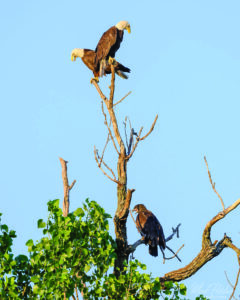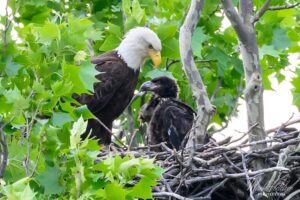By Dr. Beth Leermakers
Wonders of nature are happening in our own backyards. Two bald eagle chicks were born in March at Lake Highlands Park. Their proud parents have been hanging out at White Rock Lake since 2020. Though one eaglet hasn’t been seen since the terrible storms earlier this month, one was rehabilitated by the Blackland Prairie Rapture Center and returned to his parents at the lake.

Photos courtesy of Mark Fletcher
What’s In Store for the White Rock Eaglet?
A sky-high mansion. Bald eagle nests, called aeries, are the largest recorded bird nests. Typically found at the top of tall trees (60 to 200 feet high), aeries span four to six feet across the top and two to four feet deep. Eagles typically return to the same nest every year for decades, adding sticks and grass every time. According to the “Guinness Book of World Records,” the largest bald eagle nest was 9- and one-half feet wide, 20 feet deep, and weighed a whopping two tons!
Independence. Eaglets typically leave the nest when they are 10-14 weeks old (so about now for the White Rock baby). For the first month, the fledglings take short flights but stay close to the nest, relying on their parents for food. During these practice flights, the youngsters must learn to hunt for themselves.
White heads and tails. Bald eagles are not bald. The eagles’ name comes from the Old English word “balde,” which means white. Bald eagle chicks are born light gray and then turn brown. They develop white heads and tails when they are four to five years old.
Massive wingspan. One of the world’s largest raptors, bald eagles weigh up to 15 lbs. and are 28-38 inches in length. Their broad wingspan (up to 7 and a half feet) is perfect for soaring, allowing bald eagles to stay aloft for extended periods without flapping their wings.
Eagle vision. Bald eagles have 20/4 or 20/5 vision, which is four to five times sharper than a human’s 20/20 vision. Why? The density of rods and cones (visual cells) within a raptor’s retina may be five times greater than in the human eye. Eagles have a 340-degree field of view (compared to 180 degrees for people), so not much escapes them.

Blue Angel-worthy maneuvers. Bald eagles can soar over 10,000 feet high, using thermal air currents to support their flight. They can spot fish from a mile away, and dive toward the water at 100 miles per hour. They glide above the water, grab a fish with their feet, and fly away to dine on it.
Grab-and-go meals. That scene in the movie “The Proposal,” when the eagle swoops down and picks up the small dog, isn’t so farfetched. Bald eagles’ grip strength is 400 psi, about 10 times stronger than a person’s. This crushing grip allows eagles to grab a fish and hold onto it while they’re flying back to their dining spot.
Eagles’ strong grip also lets them snatch another bird’s prey from them in midair. Eagles steal kills from hawks, ospreys and other eagles — especially when food is scarce — making them “kleptoparasitic.” The eagle chases the bird until it drops its prey, and the eagle can grab it.
One true love. Bald eagles typically mate for life (up to 30 years). The monogamous couple breeds every year, producing one to three eggs each time. During the 35-day incubation period, the male and female take turns sitting on the eggs.
Representing their country. Since ancient times, the eagle has been considered a sign of strength. The bald eagle’s role as a U.S. national symbol is linked to its placement on the Great Seal of the United States in 1782. As the design went on to appear on official documents, currency, flags, public buildings and other government-related items, the bald eagle became an American icon.
Bald Eagles:
No Longer Endangered
Hunting, habitat destruction, and prey contaminated by DDT (a pesticide) reduced the bald eagle population from 100,000 nesting pairs in the late 1800s to around 483 pairs in 1963. Federal protections, including The Bald Eagle Protection Act (1940) and the Endangered Species Act (1973), and DDT regulations helped the species rebound from the brink of extinction. In 2016, researchers estimated there were around 143,000 bald eagles in the United States. In 2007 the bald eagle was removed from the endangered species list.
We are lucky to have the bald eagles at White Rock Lake. Let’s continue to protect their habitat.
